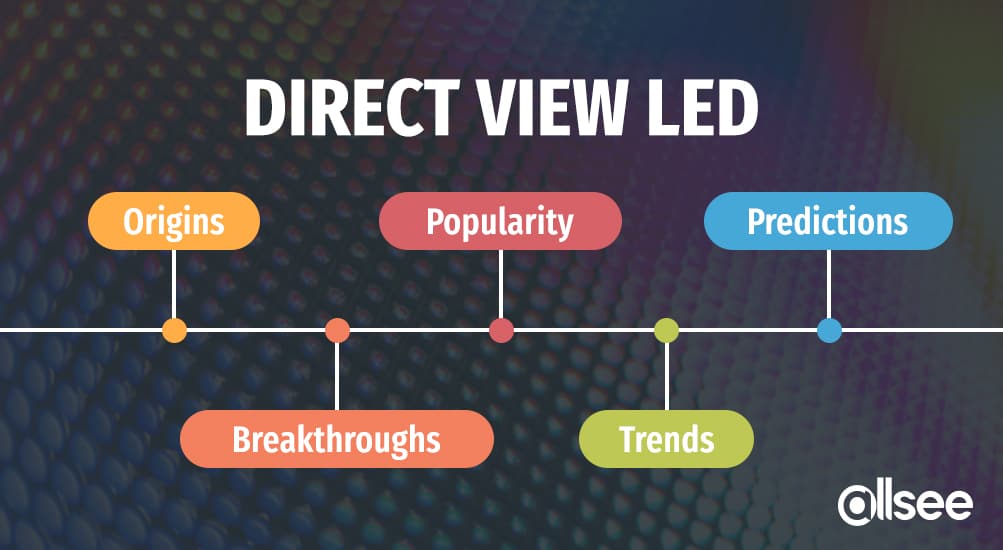
Evolution of Direct View LED Video Walls
Introduction
Video walls have always been one of the most popular types of digital signage solution. However, the technology used to create them has changed drastically over the past few decades. In this article, I explore the evolution of an emerging video wall technology known as direct view LED.
History
1960s – The first LED displays are made but are very small, single digit displays that are highly expensive and monochromatic1.
Early 1980s – CRT, which stands for cathode-ray tube, technology is used to produce the first large-scale video walls2. These were extremely bulky, like the old TVs and computer monitors.
Mid 1980s – Mitsubishi and Sony use fluorescent tube technology to build the first large-scale, full colour outdoor screens.
1992 – A technological breakthrough leads to the invention of true blue LEDs3, completing the red-green-blue colour triad and making it possible for LED displays to achieve a full range of colours4,5. The possibilities for large-scale LED video wall displays are opened up5.
Mid 1990s – Flat panel display video wall format starts with plasma screens but these have several issues, including the price, bezel size and need for expensive control technology to manage the image signal distribution.
1997 – Rock band U2 use one of the world’s first large-scale LED video walls as part of the set for their PopMart tour stage6.
Early 2000s – Video walls made up of LCD panels emerge but are highly expensive2,7.
Late 2000s – The cost of LCD panels falls, allowing LCD video walls to become one of the most popular forms of digital signage7.
Early 2010s – Instead of using three individual diodes to make up one pixel, LED technology shifts to surface mounted diodes (SMDs); this enables lower pixel pitches to become possible. LED video walls begin to grow in popularity as they are the only technology suitable for viewing in direct sunlight, capable of running at more than 5,000 nits, and allow the creation of huge bezel-less displays. However, they are mainly restricted to sports stadiums and concert arenas due to the high associated costs5.
Late 2010s – LED video wall technology continues to improve, with finer pixel pitches and curved displays becoming possible, while costs continue to fall. However, LCD video walls maintain a greater share of the market due to cost8.
2017 – Samsung becomes the first major manufacturer to exhibit a working model of a large format microLED video wall, achieving pixel pitches as low as 0.84mm9.

Where the direct view LED market sits at present and where it’s heading in the future are more subjective topics. Therefore to complete the final pieces of the puzzle in this timeline, I spoke to David Jones, Allsee’s LED Solutions Consultant, to get his expert insights.
Present Day
Chloe: “When did the term ‘direct view LED’ start being used, and why?”
David: “The term ‘direct view LED’ or ‘DV-LED’ is a very recent thing. It’s used to make the important distinction between true LED video walls and LED-backlit panels, as well as other types of LED technology such as OLED, QLED, and micro-LED.”
Chloe: “Can you give me an overview of where the DV-LED video wall market is today?”
David: “The digital signage industry has already seen video wall technology move from CRT to LCD via plasma. These transitions are a regular occurrence in technology fields, and emerging display technology is no exception. We are now in the early stages of a shift from LCD technology to LED technology. This is due to two factors: firstly, development in the technology has led to increases in the resolution of LED video walls; secondly, the cost per pixel – and therefore the cost of LED screens overall – has fallen. However, unlike when LCD replaced CRT and plasma, in this scenario I doubt it will be a total transition.
“Many display technologies came and went over the past few decades but the latest developments in LED are all fundamentally based on a very similar technology, with multiple companies working within a very defined technology area. This is why the development of direct view LED is so rapid.”
Near Future
Chloe: “Where do you see the market heading over the next few years?”
David: “The development of direct view technology for high resolution indoor screens will continue. As the methods of implementing technology improves, with the development of mini- and micro-LED technology, pixel pitches will get even finer and costs per pixel will decrease. This will mean that DV-LED will become the go-to technology for high resolution displays.
“As direct view LED displays increase in resolution, the use of flat panel video walls will gradually decline, probably over the next four to five years10.”
Distant Future
Chloe: “What about beyond that? Do you have any predictions for what the distant future might hold?”
David: “The distant future is more difficult to read. Direct view LED displays will eventually have a narrow enough pixel pitch to achieve 4K resolution on relatively small screen, making them into a consumer product when the correct price points are met – possibly with a manufacturing process not unlike bubble jet printing. Of course, the costs of these displays will keep falling as the technology becomes more widely available. In commercial spaces, it’s likely that display technology will be far more interactive and flexible on indoor and outdoor surfaces. But as with all display technology, the real value is in the content.
“As for what the next display technology will be?…… Who knows!”
Conclusion
From past to present to future, this article has been a journey through the evolution of direct view LED as a video wall technology.
If you feel inspired to explore the LED video wall market, we can support you every step of the way – so why not set up a meeting with a member of our team by emailing us at info@allsee-tech.com?
Sources
- https://designledpro.com/the-history-of-led-video-walls/
- https://blooloop.com/features/audiovisual-technology-a-short-history-of-the-videowall/
- https://www.nobelprize.org/uploads/2018/06/popular-physicsprize2014-1.pdf
- https://en.wikipedia.org/wiki/LED_display#cite_note-Kramer-2
- https://blooloop.com/features/audiovisual-a-short-history-of-the-led-large-area-video-display/
- https://saco.com/u2-pop-mart-tour/
- https://www.allsee-tech.com/digital-signage-blog/why-lcd-video-walls-are-becoming-the-most-popular-tool-in-digital-signage/
- https://www.newscaststudio.com/2018/04/06/led-video-walls-tv-studio/
- https://insights.samsung.com/2018/03/27/considering-led-displays-first-make-sure-you-understand-pixel-pitch/
- https://www.ravepubs.com/is-this-the-beginning-of-the-end-for-lcd-video-walls/

Chloe Weaver is the Digital Marketing Executive at Allsee Technologies.


